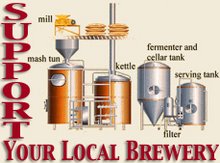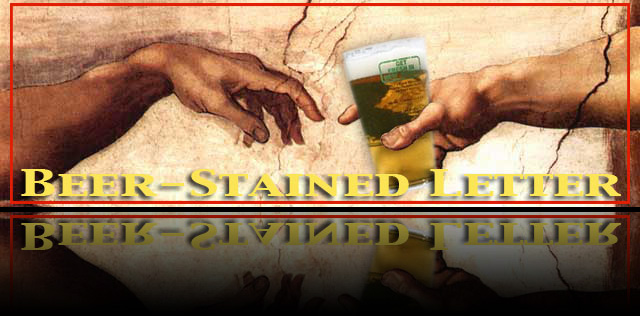 A week after supplying its first draft account, nano-sized beer-maker Cape May Brewing welcomed the public with its first open house, a four-hour meet-and-greet on Saturday that featured beer sampling and a tour of the brewery's facility nestled in an industrial park-like building alongside Cape May County Airport.
A week after supplying its first draft account, nano-sized beer-maker Cape May Brewing welcomed the public with its first open house, a four-hour meet-and-greet on Saturday that featured beer sampling and a tour of the brewery's facility nestled in an industrial park-like building alongside Cape May County Airport.
More than a dozen craft beer enthusiasts paid a call on the state's smallest beer-maker and were treated to tastes of a one-off malty brown ale-like dark IPA, and the brewery's launch beer, a deep-golden IPA informally called Jump The Jetty.
Cape May Brewing kicked off July by picking up a tap handle at Cabanas, an oceanfront bar and grill, with Jump the Jetty, which is actually registered with beer industry regulators as Cape May IPA.
Located just a bottle cap's toss from the brewery, Cabanas (on Beach Avenue in Cape May) quickly blew through the IPA over the Fourth of July holiday weekend but is now pouring the beer again thanks to a second sixtel delivery.
Notching nine brew sessions since getting its state license in mid-May, Cape May Brewing is right now the Garden State's only producing nanobrewer. Somerset County nano Great Blue, licensed in March, has been idled with some technical problems with its brewing equipment.
Cape May Brewing cranks out 25 gallons for fermentation, a production rate that for now has the brewery at about one-third of its capacity. The batch volume is produced via combined brews on a horizontal brewsculpture fashioned from repurposed 15-gallon beer kegs, a setup not unlike what you would find in a homebrewer's garage. For its sixtels, the brewery relies on Cornelius kegs, saving money by forgoing the purchase of more traditional kegging equipment.
"It's a brewery, but it's a very small brewery," says Ryan Krill, who's a partner in Cape May Brewing with his dad, Robert, and college friend Chris Henke, an engineer by profession who built the company's brewing rig. "We're not trying to take over the world, and we're not trying to get nuts. It's an affordable business plan."
 Ryan says the trio were pleased with Saturday's open house turnout, which had them filling growlers of both IPAs, selling pint glasses and logoed baseball caps, and discussing how the brewery is trying to establish itself.
Ryan says the trio were pleased with Saturday's open house turnout, which had them filling growlers of both IPAs, selling pint glasses and logoed baseball caps, and discussing how the brewery is trying to establish itself.
"I didn't really know how many people would show up today. The only advertising we did was put it on Facebook," Ryan says. "Everything for us so far has been a slow release, a soft open at Cabanas, see how the beer's received ... A lot of people want to carry us, but the whole plan is to take our time, be slow, feel out the beer business, see what we can get ourselves into."
Ryan explained how Cape May Brewing will pace its output: "We're just doing Cabanas now. After about a month, we'll have a good feel for how much they need and how much we need at the tasting room. After that point we'll see how much extra we have, then we can work on new accounts. But we're not going to try and get a new account and then find out we can't supply a new account."
Chris adds: "As we've been saying, it's just figuring it out. We go slowly so we don't get ourselves in a situation where people are yelling at us for not keeping up the supply."
 As far as the beers go, if you've had the opportunity to taste Jump The Jetty, you can expect some tweaks to dial up the hop character. The ale trends toward a milder take on IPA, less bitterness up front. "It's good, but it's not exactly where we want it to be ultimately," Ryan says. "The next batches have been hopped up more."
As far as the beers go, if you've had the opportunity to taste Jump The Jetty, you can expect some tweaks to dial up the hop character. The ale trends toward a milder take on IPA, less bitterness up front. "It's good, but it's not exactly where we want it to be ultimately," Ryan says. "The next batches have been hopped up more."
The dark IPA, likewise, sidesteps some of the more traditional hallmarks of the style, and answers some of those variations with a toasty character.
The beer is the result of attempting something off the beaten path with ingredients on hand. "We had an extra day to brew. We said let's brew something different – before that we had four batches of IPA – so we said let's try something different," Chris says. "So we collected all the hops we had in our freezer ... doubled up on our dark malt, which is crystal 50, and we got a very interesting beer.
"We really don't know what to call it. I've been calling it dark IPA because the base was kind of an IPA, but they were older hops so we didn't get the extraction that we thought we'd get out of the hops, bitterness-wise. But you do get the dark malt; that hits you at the end. You get that dark, toasty feel to it," Chris says.
NOTE: Check with the brewery's Website or Facebook page for future open houses.

















